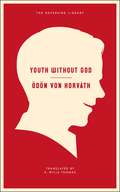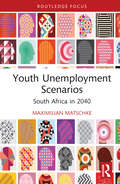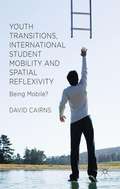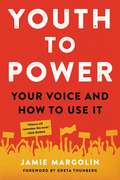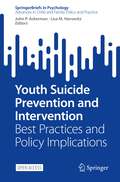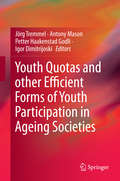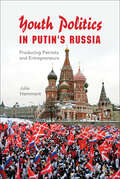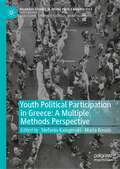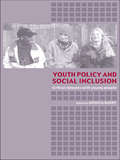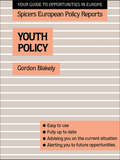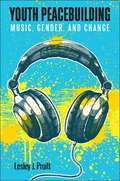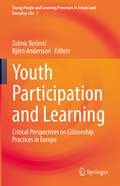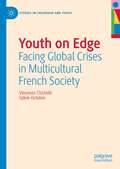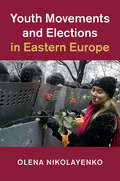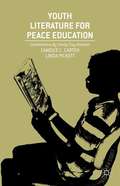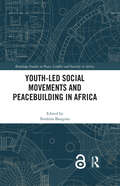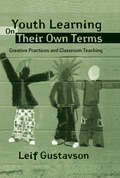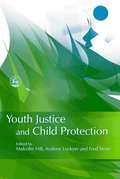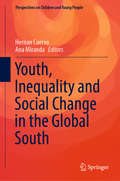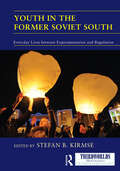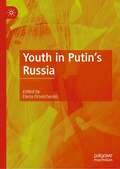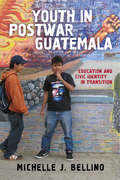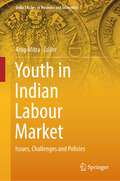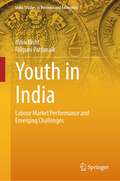- Table View
- List View
Youth Without God (Neversink)
by Odon Von Horvath R. Wills Thomas Liesl SchillingerWritten in exile while in flight from the Nazis, this dark, bizarre evocation of everyday life under fascism is available for the first time in thirty years. This last book by Ödön von Horváth, one of the 20th-century's great but forgotten writers, is a dark fable about guilt, fate, and the individual conscience.An unnamed narrator in an unnamed country is a schoolteacher with "a safe job with a pension at the end of it." But, when he reprimands a student for a racist comment, he is accused of "sabotage of the Fatherland," and his students revolt. A murder follows, and the teacher must face his role in it, even if it costs him everything. Horváth's book both points to its immediate context--the brutalizing conformity of a totalitarian state, the emptiness of faith in the time of the National Socialists--and beyond, to the struggles of individuals everywhere against societies that offer material security in exchange for the abandonment of one's convictions. Reminiscent of Camus' The Stranger in its themes and its style, Youth Without God portrays a world of individual ruthlessness and collective numbness to the appeals of faith or morality. And yet, a commitment to the truth lifts the teacher and a small band of like-minded students out of this deepening abyss. It's a reminder that such commitment did exist in those troubled times--indeed, they're what led the author to flee Germany, first for Austria, and then France, where he met his death in a tragic accident, just two years after the publication of Youth Without God. Long out of print, this new edition resurrects a bracing and still-disturbing vision. "Horváth was telling the truth. Furiously." --Shalom AuslanderFrom the Trade Paperback edition.
Youth Unemployment Scenarios: South Africa in 2040 (Routledge Contemporary South Africa)
by Maximilian MatschkeThis book examines the factors driving youth unemployment in South Africa, exploring potential future outcomes of its mass unemployment, and offering a variety of strategies to avoid an impending crisis in the country. Utilizing scenario analysis rooted in complex systems theory while building on statistical and fi eld research, the author illustrates four possible future states of youth employment in South Africa in the year 2040. This includes the South African version of the Arab Spring, where young people riot or agitate for extreme political and social change because of a belief that access to education and jobs is only possible through social status or corruption (Spring), fair access to a high number of jobs supported by Chinese interventions (Summer), a technology- driven decline in the number of jobs where merit- based access for youth is granted (Fall), and the collapse of the economy, with the economy collapsing and youth becoming increasingly desperate (Winter). The author then presents five strategies to fight youth unemployment, including training of youth to start businesses, stimulating small- and medium- sized enterprises, and sending unemployed youth abroad for skills development and to where their labour is needed. This book will be of interest to scholars of South African politics and economics, labour economics and youth studies, and readers with an interest in tackling youth unemployment independent of the country.
Youth Transitions, International Student Mobility and Spatial Reflexivity
by David CairnsDrawing on comparative country case studies, this book explores student mobility in Europe, incorporating original theoretical perspectives to explain how mobility happens and new empirical evidence to illustrate how students become mobile within their present educational and future working lives.
Youth to Power: Your Voice and How to Use It
by Jamie Margolin"Jamie Margolin is among the powerful and inspiring youth activists leading a movement to demand urgent action on the climate crisis. With determined purpose and moral clarity, Jamie is pushing political leaders to develop ambitious plans to confront this existential threat to humanity. Youth To Power is an essential how-to for anyone of any age who feels called to act to protect our planet for future generations." --- Former Vice President Al GoreClimate change activist and Zero Hour cofounder Jamie Margolin offers the essential guide to changemaking for young people.The 1963 Children's March. The 2016 Dakota Access Pipeline protests. March for Our Lives, and School Strike for Climate. What do all these social justice movements have in common?They were led by passionate, informed, engaged young people.Jamie Margolin has been organizing and protesting since she was fourteen years old. Now the co-leader of a global climate action movement, she knows better than most how powerful a young person can be. You don't have to be able to vote or hold positions of power to change the world.In Youth to Power, Jamie presents the essential guide to changemaking, with advice on writing and pitching op-eds, organizing successful events and peaceful protests, time management as a student activist, utilizing social and traditional media to spread a message, and sustaining long-term action. She features interviews with prominent young activists including Tokata Iron Eyes of the #NoDAPL movement and Nupol Kiazolu of the #BlackLivesMatter movement, who give guidance on handling backlash, keeping your mental health a priority, and how to avoid getting taken advantage of.Jamie walks readers through every step of what effective, healthy, intersectional activism looks like. Young people have a lot to say, and Youth to Power will give you the tools to raise your voice.
Youth Suicide Prevention and Intervention: Best Practices and Policy Implications (SpringerBriefs in Psychology)
by John P. Ackerman Lisa M. HorowitzThis open access book focuses on the public health crisis of youth suicide and provides a review of current research and prevention practices. It addresses important topics, including suicide epidemiology, suicide risk detection in school and medical settings, critical cultural considerations, and approaches to lethal means safety. This book offers cutting-edge research on emerging discoveries in the neurobiology of suicide, psychopharmacology, and machine learning. It focuses on upstream suicide prevention research methods and details how cost-effective approaches can mitigate youth suicide risk when implemented at a universal level. Chapters discuss critical areas for future research, including how to evaluate the effectiveness of suicide prevention and intervention efforts, increase access to mental health care, and overcome systemic barriers that undermine generalizability of prevention strategies. Finally, this book highlights what is currently working well in youth suicide prevention and, just as important, which areas require more attention and support. Key topics include: The neurobiology of suicide in at-risk children and adolescents.The role of machine learning in youth suicide prevention.Suicide prevention, intervention, and postvention in schools.Suicide risk screening and assessment in medical settings.Culturally informed risk assessment and suicide prevention efforts with minority youth.School mental health partnerships and telehealth models of care in rural communities.Suicide and self-harm prevention and interventions for LGBTQ+ youth.Risk factors associated with suicidal behavior in Black youth.Preventing suicide in youth with autism spectrum disorder (ASD) and intellectual disability (ID). Youth Suicide Prevention and Intervention is a must-have resource for policy makers and related professionals, graduate students, and researchers in child and school psychology, family studies, public health, social work, law/criminal justice, sociology, and all related disciplines.
Youth Quotas and other Efficient Forms of Youth Participation in Ageing Societies
by Jörg Tremmel Antony Mason Petter Haakenstad Godli Igor DimitrijoskiThis book examines ways to ensure that the rights, interests and concerns of young people are properly represented in Western democracies. One new proposal is the introduction of youth quotas in political institutions in order to counter the possible marginalization of young people caused by demographic ageing and, thereby, an overrepresentation of the interests of the elderly. The book explores key questions regarding the implementation of youth quotas from different perspectives, including philosophy, political science, sociology and demography. It examines whether youth quotas and other measures that give the young more voice and influence in political institutions are a good means for promoting the cause of intergenerational justice. In particular, it investigates how and if youth quotas can be used to ensure that the environmental interests of young and future generations are being taken into account. In addition, the book introduces an innovative model that would give a right to vote to minors without voting age boundaries. The book also discusses suffrage reforms through lowering the voting age in Western countries, as well as introducing methods especially aimed at raising the skills of children necessary for societal citizenship and empowerment of young citizens. The volume will help raise awareness and knowledge about the intergenerational implications of demographic changes in Western democracies, where ageing societies are increasingly turning into gerontocracies. It offers readers deep insight into how youth quotas in particular (and others forms of youth participation in general) might be efficient methods to ensure that younger generations are included in the political decision making process and other activities in society.
Youth Politics in Putin's Russia: Producing Patriots And Entrepreneurs (New Anthropologies of Europe)
by Julie HemmentJulie Hemment provides a fresh perspective on the controversial nationalist youth projects that have proliferated in Russia in the Putin era, examining them from the point of view of their participants and offering provocative insights into their origins and significance. The pro-Kremlin organization Nashi ("Ours") and other state-run initiatives to mobilize Russian youth have been widely reviled in the West, seen as Soviet throwbacks and evidence of Russia's authoritarian turn. By contrast, Hemment's detailed ethnographic analysis finds an astute global awareness and a paradoxical kinship with the international democracy-promoting interventions of the 1990s. Drawing on Soviet political forms but responding to 21st-century disenchantments with the neoliberal state, these projects seek to produce not only patriots, but also volunteers, entrepreneurs, and activists.
Youth Political Participation in Greece: A Multiple Methods Perspective (Palgrave Studies in Young People and Politics)
by Stefania Kalogeraki Maria KousisThe overarching aim of this edited volume is to investigate different modes, patterns and determinants of youth political participation in Greece, since the economic crisis, by incorporating a variety of quantitative and qualitative methods. The chapters examine different forms of youth political participation, from institutionalized (such as voting, or membership in political parties) to non-institutionalized (such as signing petitions, protesting through demonstrations or occupations, and political consumerism). Moreover, the chapters shed light on diverse aspects of youth political participation, such as the interlinkages between occupational precarity and political behaviour, the spatial portrait of youth political engagement in rural, suburban and urban Greek contexts, the engendered aspects of political involvement, the pivotal role of protest events in youth political socialization and in mobilization in contentious political actions, the different impacts of priming inequality on youth’s political beliefs, depending on different modes of thinking, as well as the key features of youth-related and youth-led (non-state) organisations operating in Greece. The aforementioned aspects are examined at the micro, meso or/and macro level through distinct methodological approaches including panel survey, experimental survey, biographical interviews, in-depth interviews and action organization analysis, carried out in the context of the EURYKA (European Commission) project.
Youth Policy and Social Inclusion: Critical Debates with Young People
by Monica BarryTaking a holistic and multidisciplinary approach this book identifies and analyzes the factors which promote or discourage social inclusion of young people in today’s society. It critically examines the discriminatory attitudes towards young people, and focuses on the 'problem' of adults rather than the 'problem' of young people themselves. The authors ask searching questions about society's capacity and willingness to be more socially inclusive of young people in terms of policy and practice, and explore the extent to which young people have access to status, rights and responsibilities as young adults. Challenging existing theory the book covers issues including: citizenship, education, rights, youth transactions, drug use, homelessness, teenage pregnancy and unemployment. Incorporating the views and experiences of young people themselves, the book highlights the strengths and weaknesses of the academic contribution and suggests ways forward for a more inclusive society.
Youth Policy (Spicers European Policy Reports)
by Gordon BlakelyEuropean co-operation has a special role in relation to youth. Both the Council of Europe and the European Community have developed specific initiatives to promote the interests of youth, and to place them in a European-wide context. These initiatives cover economic, social, educational and cultural matters. New opportunities have been created for youth exchanges and an increasingly important application of the EC Social Fund is concerned with youth issues. This volume has a wider focus than the others in this series in that it covers the initiatives of both the European Community and some of the work done by the Council of Europe. It explains how their youth policies have developed, the differences between them, it guides the reader as to its current programmes, and it also discusses proposals affecting the immediate future. This volume will be of special interest to the diverse audience concerned with youth policy: public administrators, educationalists, social and cultural bodies, youth representatives and young individuals.
Youth Planning Charrettes: A Manual for Planners, Teachers, and Youth Advocates
by Bruce RaceInvest in the future! Involve young people in planning. Learn how to design charrettes, starting with workshops and ending with lessons learned. This book explores various approaches to involving youth in schools, museums, and citizen groups. It's a complete guide to successful community charrettes for younger participants (K-8). First published in 1998. Routledge is an imprint of Taylor & Francis, an informa company.
Youth Peacebuilding: Music, Gender, and Change (SUNY series, Praxis: Theory in Action)
by Lesley J. PruittThis book highlights the important role youth can play in processes of peacebuilding by examining music as a tool for engaging youth in such activities. As Lesley J. Pruitt discusses throughout the book, music—as expression, as creation, as inspiration—can provide many unique insights into transforming conflicts, altering our understandings, and achieving change. She offers detailed empirical work on two youth peacebuilding programs in Australia and Northern Ireland, countries that appear overtly peaceful, but where youth still face structural violence and related direct violence at the community level. She also pays careful attention to the ways in which gender norms might influence young people's participation in music-based peacebuilding activities. Ultimately, the book defines a new research area linking youth cultures and music with peacebuilding practice and policy.
Youth Participation and Learning: Critical Perspectives on Citizenship Practices in Europe (Young People and Learning Processes in School and Everyday Life #7)
by Zulmir Bečević Björn AnderssonThis book contributes to the studies on learning processes occurring outside “traditional” socialization settings such as family and school, by analysing civic and political participation and learning experiences. In this perspective, the book delves into the connections between the concepts of learning and participation and, in various ways and from different perspectives, critically interrogates learning and participation as interrelated phenomena, with the aim of revealing complexities implicated in pathways to adulthood. Being interdisciplinary in its nature (contributors come from disciplinary backgrounds such as educational sciences, child and youth studies, social work, sociology and political science), the volume provides an up-to date analysis of contemporary issues connected to youth participation and learning. The work taps into central areas of everyday life of young people and youth meaning-making and generates and presents qualitative knowledge about what it means to be young in Europe today.
Youth on Edge: Facing Global Crises in Multicultural French Society (Studies in Childhood and Youth)
by Vincenzo Cicchelli Sylvie OctobreThis book explores disrupted youth cohesion in France within the context of multiple ongoing global economic, migratory, social, political, and security-related crises. While these trends can be observed in numerous Western societies, France provides a unique case study of various anti-cosmopolitan and anti-Enlightenment movements shaping youth conditions and reconfiguring relationships between the individual, the group, and society. The authors undertook in-depth interviews with French young people between the ages of 18 to 30 years old to inquire into how they experience "vivre ensemble" (living together) in a time of rising economic inequalities and multicultural tensions. Through these findings, they invite decision-makers, politicians, educators, and parents to propose a renewed narrative of social cohesion for youth who are not disillusioned, but deeply on edge.
Youth Movements and Elections in Eastern Europe (Cambridge Studies in Contentious Politics)
by Olena NikolayenkoAt the turn of the twenty-first century, a tide of nonviolent youth movements swept across Eastern Europe. Young people demanded political change in repressive political regimes that emerged since the collapse of communism. The Serbian social movement Otpor (Resistance) played a vital role in bringing down Slobodan Milosevic in 2000. Inspired by Otpor's example, similar challenger organizations were formed in Azerbaijan, Belarus, Georgia, and Ukraine. The youth movements, however, differed in the extent to which they could mobilize citizens against the authoritarian governments on the eve of national elections. This book argues that the movement's tactics and state countermoves explain, in no small degree, divergent social movement outcomes. Using data from semi-structured interviews with former movement participants, public opinion polls, government publications, non-governmental organization (NGO) reports, and newspaper articles, the book traces state-movement interactions in five post-communist societies: Azerbaijan, Belarus, Georgia, Serbia, and Ukraine. Uses data from interviews with former movement participants, public opinion polls, government publications, non-governmental organization (NGO) reports, and newspaper articles. Provides a comparative analysis of state-movement interactions in five post-communist societies: Azerbaijan, Belarus, Georgia, Serbia, and Ukraine. Highlights a record of civic activism in the selected countries, and unravels the significance of learning from prior protest campaigns.
Youth Literature for Peace Education
by Candice C. Carter Linda PickettCarter and Pickett explore how educators and families can teach peace education through youth literature and literacy development. Showing how to assess, choose, and make use of literature that can be used to teach both literacy and peace education, they walk through individual methods: recognizing and teaching different portrayals of conflict in youth literature, analyzing characterization, and examining the role of illustrations. Educators who want to incorporate peace education within a broader, literacy-focused curriculum, and peace educators looking for age-appropriate materials and methodologies will find Youth Literature for Peace Education a rich and interdisciplinary resource.
Youth-Led Social Movements and Peacebuilding in Africa (Routledge Studies in Peace, Conflict and Security in Africa)
by Ibrahim BanguraThis book critically examines and analyses the active role played by youth-led social movements in pushing for change and promoting peacebuilding in Africa, and their long-term impacts on society. Africa’s history is characterised by youth movements. The continent’s youth populations played pivotal roles in the campaign against colonialism and, ever since independence, Africa’s youth have been at the center of social mobilisation. Most recently, social media has contributed significantly to a further rise in youth-led social movements. However, the impact of youth voices is often marginalised by patriarchal and gerontocratic approaches to governance, denying them the place, voice, and recognition that they deserve. Drawing on empirical evidence from across the continent, this book analyses the drivers and long-term impacts of youth-led social movements on politics in African societies, especially in the area of peacebuilding. The book draws attention to the innovative ways in which young people continue to seek to re-engineer social space and challenge contexts that deny them their voice, place, recognition and identity. This book will be of interest to researchers across the fields of social movement studies, youth studies, peace and conflict studies, history, political sciences, social justice, and African studies.
Youth Learning On Their Own Terms: Creative Practices and Classroom Teaching (Critical Youth Studies)
by Leif GustavsonYouth Learning On Their Own Terms convincingly shows how developing a respect and understanding of the youth-initiated creative practices that occur outside schools can offer educators the opportunity to directly influence their teaching in schools by making classroom spaces personally meaningful and rigorous for both students and teachers.
Youth Justice and Child Protection
by Malcolm Hill Andrew Lockyer Fred StoneThis book is an examination of recent developments in the areas of youth justice and child protection. It investigates how well young people and the societies in which they live are served by judicial and service systems. Consideration is given to those in care - in young offenders' institutions, foster families and residential homes - as well as those living with their families. A broad range of international experts discuss the largely segregated youth justice and children's legal and service systems in England and Wales, other parts of Western Europe and the US, and compare these with Scotland's integrated system. The implications of these arrangements are considered for the rights of children and parents on the one hand and society on the other. The contributors also provide insights into the rationale for current and proposed policies, as well as the efficacy of different systems. This book will be an important reference for policy-makers, social workers, lawyers, magistrates and equivalent decision makers, health professionals, carers, and all those working in youth justice and child protection. It is highly relevant for academics and students interested in children, citizenship, youth crime, child welfare and state-family relations.
Youth, Inequality and Social Change in the Global South (Perspectives on Children and Young People #6)
by Hernan Cuervo Ana MirandaThis book gathers international and interdisciplinary work on youth studies from the Global South, exploring issues such as continuity and change in youth transitions from education to work; contemporary debates on the impact of mobility, marginalization and violence on young lives; how digital technologies shape youth experiences; and how different institutions, cultures and structures generate a diversity of experiences of what it means to be young. The book is divided into four broad thematic sections: (a) Education, work and social structure; (b) Identity and belonging; (c) Place, mobilities and marginalization; and (d) Power, social conflict and new forms of political participation of youth.
Youth in the Former Soviet South: Everyday Lives between Experimentation and Regulation (ISSN)
by Stefan B. KirmseThis book offers the first comprehensive analysis of youth, in all its diversity, in Muslim Central Asia and the Caucasus. It brings together a range of academic perspectives, including media studies, Islamic studies, the sociology of youth, and social anthropology. While most discussions of youth in the former Soviet South frame the younger generation as victims of crisis, as targets of state policy, or as holy warriors, this book maps out the complexity and variance of everyday lives under post-Soviet conditions. Youth is not a clear-cut, predictable life stage. Yet, across the region, young people’s lives show forms of experimentation and regulation. Male and female youth explore new opportunities not only in the buzzing space of the city, but also in the more closely monitored neighbourhood of their family homes. At the same time, they are constrained by communal expectations, ethnic affiliation, urban or rural background and by gender and sexuality. While young people are more dependent and monitored than many others, they are also more eager to explore and challenge. In many ways, they stand at the cutting edge of globalization and post-Soviet change, and thus they offer innovative perspectives on these processes. This book was published as a special issue of Central Asian Survey.
Youth in Putin's Russia
by Elena OmelchenkoThis edited volume sheds light on the lives of young people in various central and peripheral regions of Russia, including youth belonging to different ethnic and religious groups and who have differing views on contemporary politics. While the literature continues to grow regarding the inclusion of youth in global contexts, the specific cultural, political, and economic circumstances of being young in Russia make the Russian case unique. Chapter authors focus on four key aspects that characterize the youth experience in contemporary Russia: cultural practices and value affiliations, citizenship and patriotism, ethnic and religious diversity, and the labor market. This collection will appeal to readers interested in contemporary life in Russia and looking for the latest empirical material on youth identities and cultures, as well as those looking to learn about the critical viewpoint of local academics regarding the ongoing processes in contemporary Russian society.
Youth in Postwar Guatemala: Education and Civic Identity in Transition
by Michelle J. BellinoIn the aftermath of armed conflict, how do new generations of young people learn about peace, justice, and democracy? Michelle J. Bellino describes how, following Guatemala’s civil war, adolescents at four schools in urban and rural communities learn about their country’s history of authoritarianism and develop civic identities within a fragile postwar democracy. Through rich ethnographic accounts, Youth in Postwar Guatemala, traces youth experiences in schools, homes, and communities, to examine how knowledge and attitudes toward historical injustice traverse public and private spaces, as well as generations. Bellino documents the ways that young people critically examine injustice while shaping an evolving sense of themselves as civic actors. In a country still marked by the legacies of war and division, young people navigate between the perilous work of critiquing the flawed democracy they inherited, and safely waiting for the one they were promised.
Youth in Indian Labour Market: Issues, Challenges and Policies (India Studies in Business and Economics)
by Arup MitraThis book addresses labour market participation issues of youth in India, and follows an inter-disciplinary approach. It carries out both quantitative and qualitative assessments for an in-depth understanding of these issues. It collates a wide range of concerns both from supply and demand side, and instead of reflecting on the empirical questions only, the book reflects on various analytical questions as well. Some other challenges being discussed here are inadequacy of skill and compulsion to participate in the labour market, concentration in activities with excess supplies of labour, unrecognised work experience, lack of upward mobility, and working with information asymmetry. Caste and gender disadvantages are an instrumental part of the book. Problems of educated and uneducated youth are quite different and the book analyses them separately. Besides, it refers to a wide range of issues relating to occupational flexibility. It also discusses skill imparting institutions and themajor lacuna associated with their functioning. Social unrest and threats to the prospects of future growth in the absence of adequate youth employment are some of the economic and political issues which the book covers. Unraveling the threads of the concerns mentioned above, the book finally comes up with policy suggestions. It is a great resource for researchers, industry watchers, and policy makers who are interested in inclusive and sustainable growth.
Youth in India: Labour Market Performance and Emerging Challenges (India Studies in Business and Economics)
by Nitin Bisht Falguni PattanaikThis book provides an overview of youth labour force and workforce participation in India and explores the dynamics of changing youth labour market in India. Despite notifying a demographic dividend phase, a significant share of youth witnessed higher exclusion (unemployment and not in employment, education or training) from the Indian labour market. Therefore, this book investigates the role of education in labour market and examines open unemployment. It conceptualizes the not-in-employment-education-or-training (NEET) status of youth in Indian context and explores the heterogeneity of NEET youth by analysing the push and pull role of demographic and socio-economic variables. Furthermore, this book examines the nexus of youth labour market status and economic growth in India to provide plausible recommendations for youth's higher, inclusive and sustained participation in the labour market and the country's development pathway. The book creates room for necessary policy interventions considering the changing dynamics of youth labour market and contemplating the challenges of skill, technology and Industry 4.0., which entails a higher emphasis on ‘re-shape’, ‘re-focus’ and ‘re-share’ for enhanced and sustained inclusion of youth in labour market. It is a necessary resource for students, researchers, policymakers, and industry partners interested in exploring and understanding the political economy of youth labour market in India.
